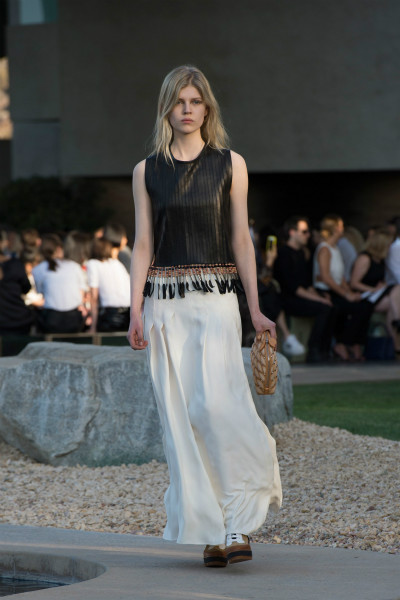- 传世开服网
Louis Vuitton的沙漠风暴(2)
-
The notion of art as a catalyst of travel was born out by a visit to the Palm Springs Art Museum, where Louise Bourgeois and Barbara Hepworth sculptures through Roy Lichtenstein panels to Anselm Kiefer’s meld of steel, plaster and fabric seemed to firm up the idea of the desert city as wedded to modern art.
The cruise collection was neatly balanced between long soft dresses for women who looked like they could take on the world with their sneaker strides; and the harder, sportier feeling of leather jackets in Seventies ginger and rust colours. There was also a touch of sweetness in chains of blue flowers on a white dress, daisies embroidered on black brogues and the girly look of soft drapes at the shoulders or patterns on shorts with cotton shirts.
Ghesquière referred to the meld of styles he found inside the Bob Hope Estate, which contrasts architectural brutalism with something sweet, referring to butterfly prints in a bathroom and greenery painted round an indoor swimming pool, while concrete and raw desert stone make up the house’s core.

Actress Michelle Williams
Picture credit: Suzy Menkes/Instagram
I should have asked the designer about Coachella, and whether the music and arts festival in Palm Springs, with its Summer of Love vibe, had also triggered the wispy dresses hardened with leather belts. I might also have inquired whether a cruise collection should seem at times so thick and wintery, especially in this Californian dust bowel.But Nicolas was insisting to me that he was very French and that if there was a local element it was the influence of the desert, as in the black palms on the bags and the sense of a community of women.
So had the Bob Hope house brought to Louis Vuitton a return to the futurism that was part of Ghesquière’s vision from his earliest days at Balenciaga? “I have heroines in my head and some may look futuristic and some everyday,” Nicolas said. “I visualised it as multiple. Not one woman but many different personalities.”
- 共2页:
- 上一页
- 1
- 2
- 下一页




